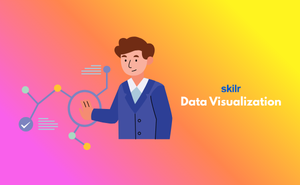👇 CELEBRATE CLOUD SECURITY DAY 👇
00
HOURS
00
MINUTES
00
SECONDS

The Data Visualization exam evaluates candidates' proficiency in creating informative and visually compelling data visualizations to communicate insights and trends from complex datasets effectively. Data visualization is the graphical representation of data to facilitate understanding and decision-making. This exam covers essential principles, techniques, and best practices related to data visualization, including data analysis, storytelling, design aesthetics, and interactive visualization tools.
The Data Visualization exam covers the following topics :-
Industry-endorsed certificates to strengthen your career profile.
Start learning immediately with digital materials, no delays.
Practice until you’re fully confident, at no additional charge.
Study anytime, anywhere, on laptop, tablet, or smartphone.
Courses and practice exams developed by qualified professionals.
Support available round the clock whenever you need help.
Easy-to-follow content with practice exams and assessments.
Join a global community of professionals advancing their skills.
Yes, most certification providers offer preparatory resources such as practice exams, online tutorials, and hands-on labs. Additionally, there are many third-party platforms that provide mock exams and learning materials specifically designed for the Data Visualization Certification Exam.
If you don’t pass the exam, you can usually retake it after a waiting period of 14 to 30 days, depending on the certification provider. Each attempt typically requires a fee, and it's important to review the exam guidelines to understand the retake policy specific to the certifying body.
The exam consists of multiple-choice, multiple-response, and scenario-based questions that assess both theoretical knowledge and practical skills. It may also include interactive questions, requiring candidates to perform tasks within data visualization tools.
Yes, most certification providers offer the exam as an online, proctored test. This allows candidates to take the exam remotely, from any location, provided they meet the technical requirements for online proctoring.
The exam typically lasts 90 minutes to 2 hours. A passing score generally ranges from 70% to 75%, depending on the certifying body. The exact passing score may vary, so it’s important to review the specific exam guidelines provided by the certifying organization.
The exam emphasizes popular tools like Tableau, Power BI, Google Data Studio, and advanced libraries such as D3.js and Plotly for creating customized, interactive visualizations. Familiarity with these tools is crucial for success.
The exam covers topics such as data preparation, design principles for visualizations, using data visualization tools, creating dashboards, data storytelling, advanced visualization techniques, and best practices in presenting data to stakeholders.
The exam is designed to assess a candidate's ability to transform raw data into clear, actionable insights through visual representations. It evaluates skills in using various data visualization tools, techniques, and design principles to create effective, intuitive visualizations.
Candidates should have a foundational understanding of data analysis and experience using data visualization tools like Tableau, Power BI, or Google Data Studio. Familiarity with basic statistics, data manipulation (using SQL, Python, or R), and design principles for creating clear visuals is also recommended.
This exam is ideal for data analysts, business analysts, marketing analysts, data scientists, and professionals involved in data-driven decision-making or those looking to enhance their skills in presenting data visually for better business insights.